Parking and Mobility Study
ST. JOSEPH MEDICAL CENTER
FINAL REPORT (DRAFT)
May 2021


FINAL REPORT (DRAFT)
May 2021

The Parking and Mobility Study comes at a critical moment for PeaceHealth and St. Joseph Medical Center. The system is engaged in a comprehensive Master Facility Plan (MFP), a long-term strategic plan that identifies the infrastructure needed to support planned growth for its Northwest, Columbia, and Oregon networks.
Parking and transportation are key elements to success. PeaceHealth and St. Joseph must address challenges head-on, knowing that they must innovate if they want to continue to grow, provide high-quality medical care, attract and retain the best talent, and ensure a positive and rewarding work environment for their valued employees.
Initiated in 2019, the Parking and Mobility Study is a complementary effort to the MFP, facilitating a “deep dive” on parking and mobility infrastructure, policies, and programs at four individual campuses.1
The primary goals of this study are to:

Identify opportunities to improve the patient, visitor, and caregiver parking and travel experience.
Identify policy, programmatic, and management strategies to improve parking and mobility for all users.
This report summarizes the planning process, key findings, and recommendations specific to the St. Joseph Medical Center. The study includes a “toolkit” of recommendations, recognizing that parking and transportation challenges are best addressed across multiple strategies.
Implementation will take time and immediate efforts should focus on a subset of high-priority actions. In the end, this report offers a “roadmap” for improvement as the campus grows and evolves.
1
This study began in 2019 and followed a five-phase process. A set of draft recommendations was proposed in February 2020, but the project was paused in March 2020 at the start of the COVID-19 pandemic. In February 2021, a project restart was initiated, and recommendations were updated considering the advancement of the MFP and campus changes that occurred due to COVID-19.
ParkingInventory+OccupancyDataCollection
SiteAssessmentExistingConditionsFactSheetsStaffWorkingGroupsCaregiverParking+TravelSurveyInterviews+FocusGroups DraftStrategies ProjectRestart+StrategyRefreshCOVID-19ProjectPause
Existing Conditions
Stakeholder Engagement
Goals + Objectives
Strategy Development
3 Chapter Chapter Chapter Chapter 4 5
2
Summary
Provides a summary of the existing conditions analysis, including highlights of the data collection process, stakeholder engagement efforts, and key takeaways that informed the development of strategies.
Documents the goals and objectives that informed the development of strategies, shaped identification of priorities, and will guide implementation over time.
Details a comprehensive and diverse set of strategies that make up the parking and mobility toolkit.
Outlines principles to guide implementation and highlights the top priority strategies.
The existing conditions analysis conducted in early to mid-2019 identified a core set of issues and opportunities at St. Joseph Medical Center. The analysis included a review of quantitative data, as well as a qualitative assessment of campus infrastructure and the travel experiences of patients, visitors, and caregivers. All data collection was conducted prior to COVID-19.
The specific analysis efforts included:
Data collection of parking inventory, including the number of spaces and type of regulations by parking lot/garage.

Data collection of parking occupancy, including the number of parked vehicles by time of day and lot/ garage. Counts were taken in both April and October 2019.
Caregiver travel survey, documenting the parking behavior and travel preferences for 517 caregivers at St. Joseph across multiple job categories.
Stakeholder interviews and focus groups, capturing detailed feedback from caregivers, managers, and parking staff.
Site assessments, including multiple site visits and walking tours to document field conditions.
This chapter provides a summary of the high-level findings that informed the development of recommendations. Detailed data and information can be found in Appendix A – Existing Conditions Fact Sheets and Appendix B –Caregiver Travel Survey Analysis.
There are total PeaceHealth-managed parking spaces, including the PeaceHealth clinics adjacent to campus.
Out of those parking spaces...
1,669 of parking spaces are dedicated for a mix of other uses
21% of parking spaces, including PeaceHealth clinics, are designated exclusively for patients or visitors
48% of parking spaces are unmarked and available for all users 12% of parking spaces are dedicated exclusively for caregivers 19%
Parking occupancy is at or near 100% for most PeaceHealth lots/garages at peak period. Lots on the west side of campus are the most popular.
100%
There are 11 non-PeaceHealth clinics located adjacent to the medical center. Many of these clinic lots have available parking spaces at peak times.
Prior to COVID-19, 92% of caregivers drove alone to work.
Another 3% were dropped off or shared a ride.
About 5% of caregivers walked, biked, or took transit to campus. Only a handful of caregivers telecommuted.

Unmarked
Through a series of interviews, focus groups, and field data collection, the following top takeaways were identified for St. Joseph Medical Center.
Additional parking supply is needed, but new supply alone will not solve the parking problem.
Given the level of current parking demand and proposed campus growth, additional parking supply should be programmed, and a new garage is currently being evaluated as part of the Master Facility Plan. New supply, however, is not a “silver bullet” and solving St. Joseph’s parking challenges will require investment in multiple areas.
The parking experience impacts caregiver satisfaction.
The level of parking-related stress for caregivers at St. Joseph is high. The lack of consistently available parking increases workplace frustration and decreases job satisfaction. Investment in parking and transportation can support caregiver attraction and retention efforts.
Caregivers continue to park in non-designated spots. There are no consequences. The parking situation minimizes our ability to respond quickly and it decreases our efficiency. Parking has become a major dissatisfy-er.
New tools and policies can improve the efficiency of the parking system.
Current parking management tools do not reflect industry best practices. New permit, valet, and enforcement systems can make the current system work better for all, improve user convenience, and reduce long-term administrative costs. Existing parking policies are not enforced consistently, further impacting system efficiency.
Investment in wayfinding and multimodal infrastructure will create a safer and more active campus.
Pedestrian circulation, campus safety, and parking space size were identified as key issues. Investments in lighting, sidewalks, bike lanes, wayfinding, and security systems will ensure that all campus parking spaces are used efficiently, and people have a pleasant and comfortable experience coming to St. Joseph.
I reached out in the classifieds to see if anyone wanted to carpool, but no one did.
Walk to parking garage is poorly lit. Garage is in far back corner.
We need a bike plan, bike share, and financial incentives to get to work other ways.
Driving is, and will be, the primary mode of access to campus. More and better travel options can free up parking spaces over time.
Most caregivers and patients live in locations where driving is the only option. However, some caregivers did express a desire for more non-driving options and incentives. Even a small shift away from driving to walking, biking, transit, or shared rides will free up parking spaces across campus.
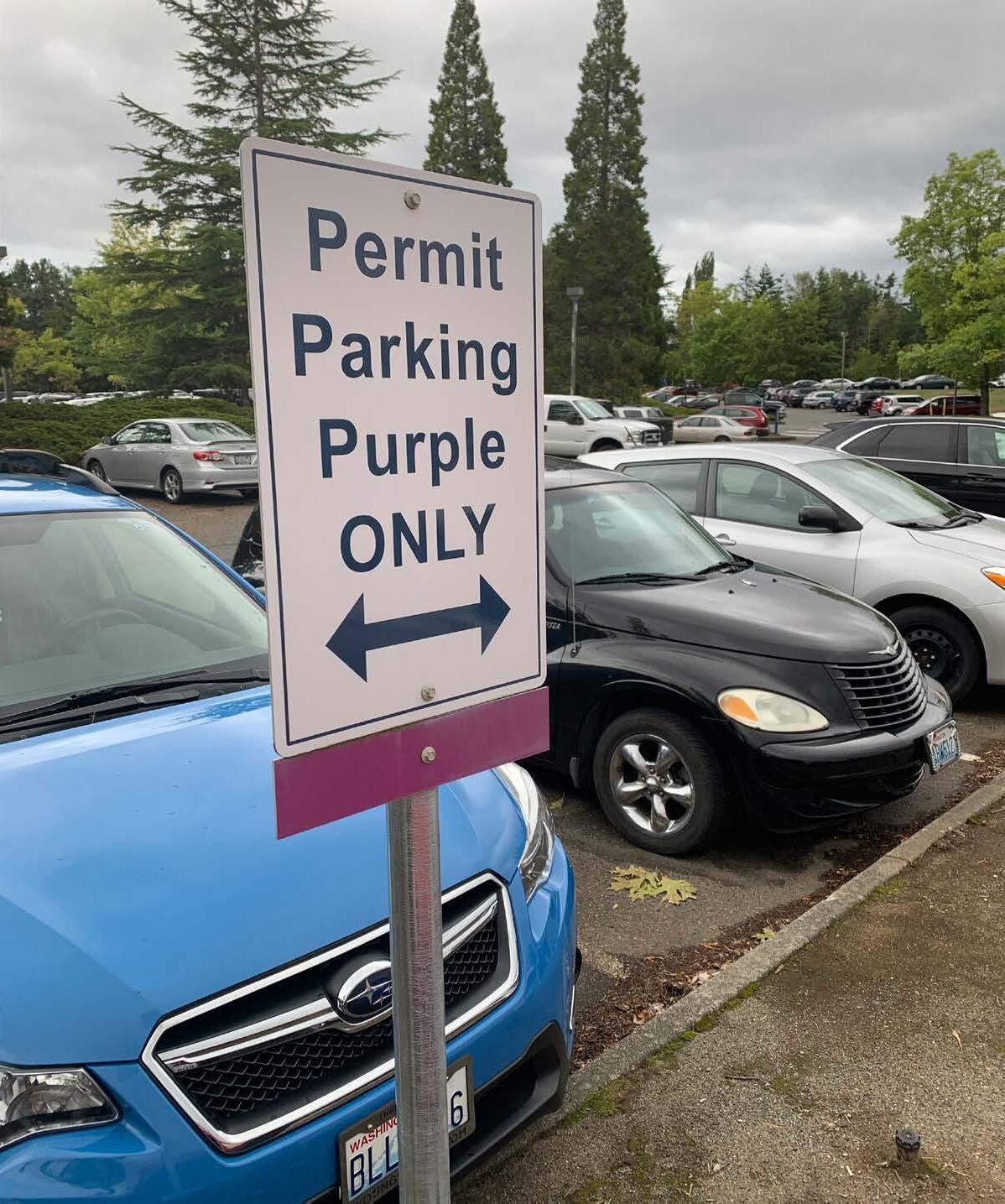
I have to take two buses, which turns a 15 minute commute into a 1.5 hour commute.
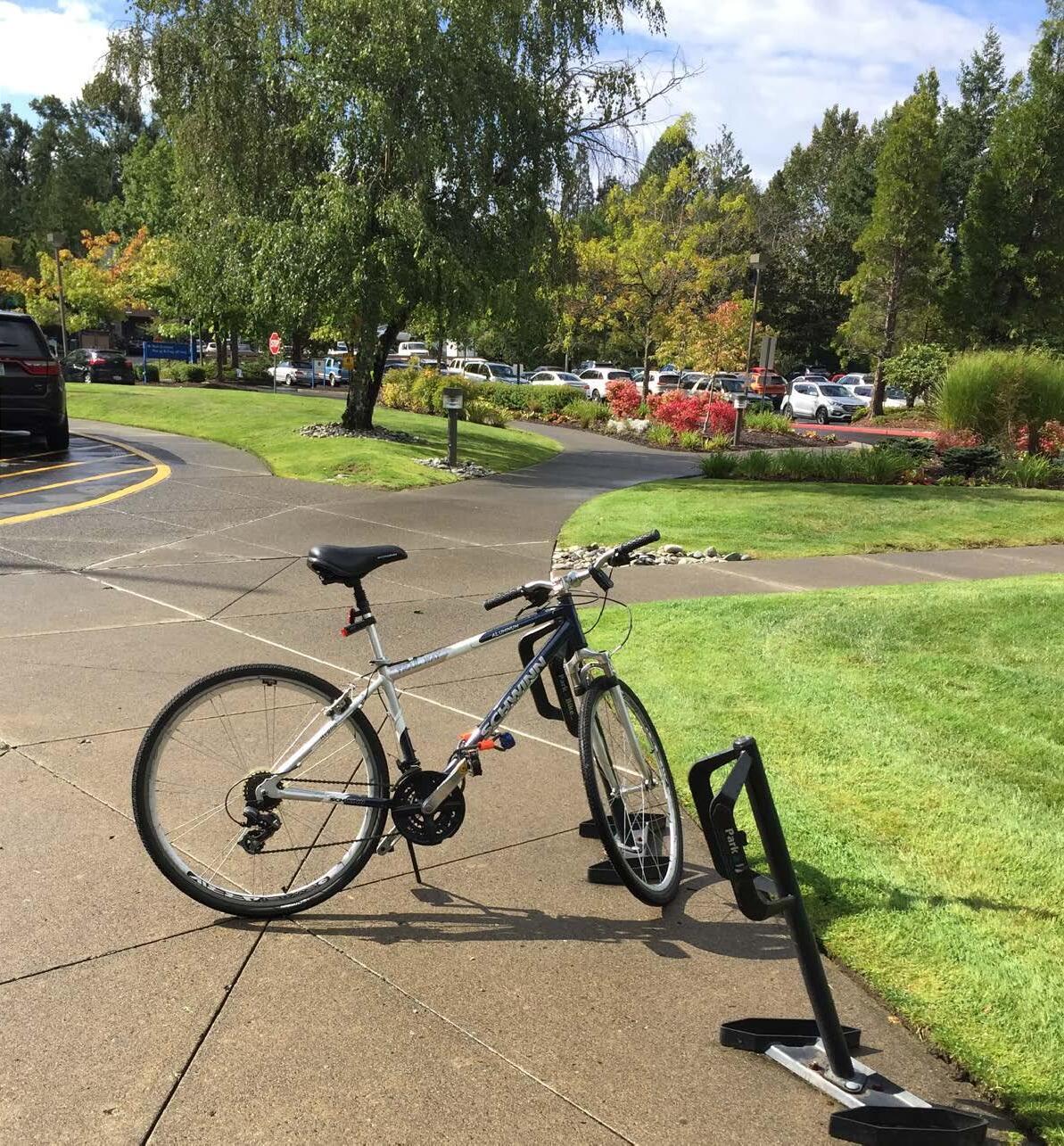

I would bike more, but am required to be at too many locations on many days.



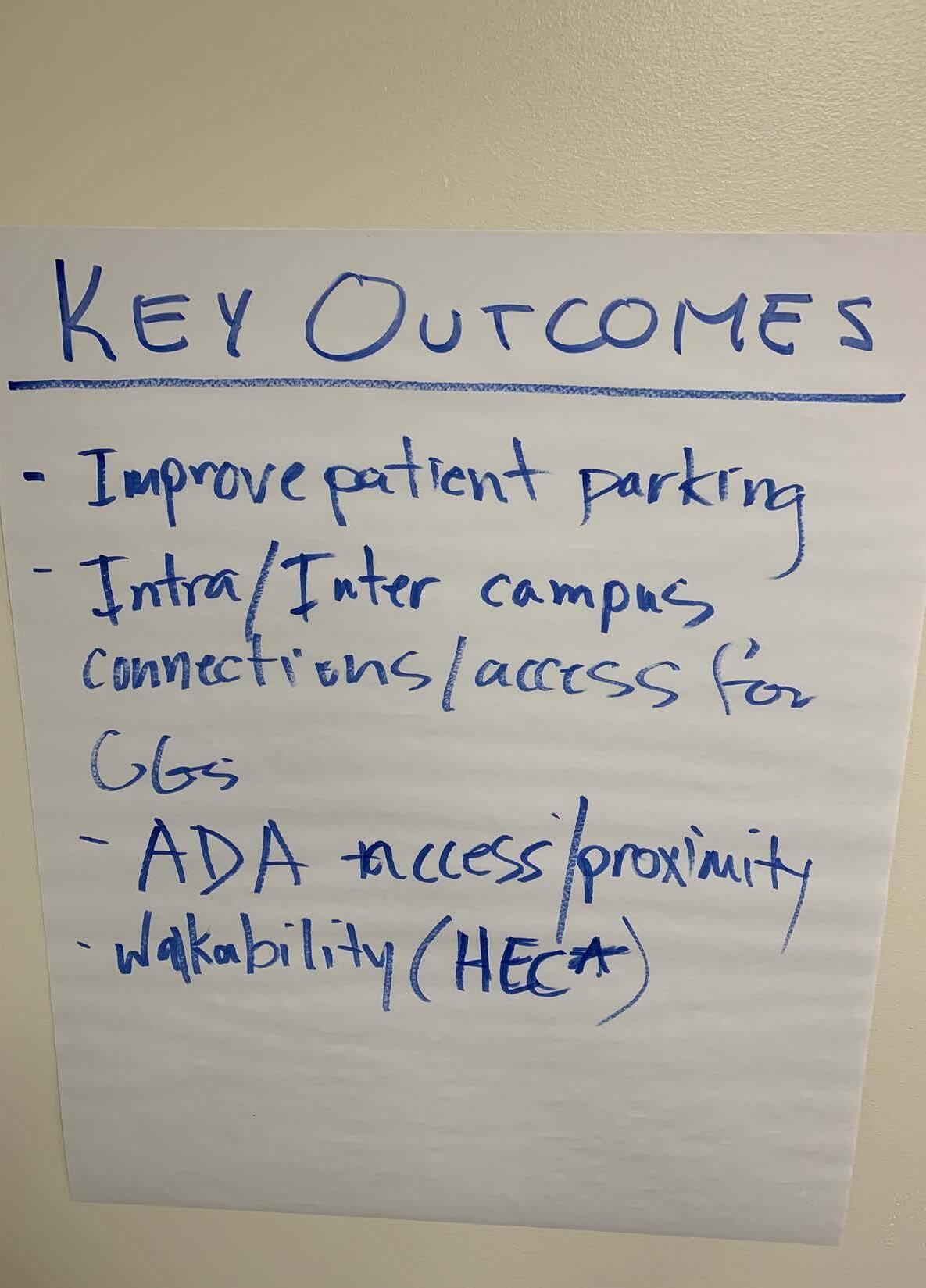
The staff from neighboring clinics use visitor parking.

For shifts starting after 11 a.m. there is no parking and staff need to park at the HEC building.


The data collection and analysis, combined with stakeholder engagement, helped clarify the problem statement and the core challenges at St. Joseph Medical Center. To properly define a set of recommendations, goals and objectives specific to parking and mobility were developed in collaboration with St. Joseph staff. The benefits of the goals framework are two-fold.
1
2
First, it ensures that investments made in parking and mobility, above all, support and reinforce PeaceHealth’s mission and values. The PeaceHealth mission, anchored in a commitment to “Exceptional Medicine and Compassionate Care,” and its four core values – Respect, Stewardship, Collaboration, and Social Justice – should inform decisions about how to get people to, from, and within campus.
Second, the goals framework can guide planning, operations, and management of the parking and transportation system for the longterm. The campus will evolve and its people will come and go, but the goals can anchor staff workplans to achieve a desired set of outcomes for both St. Joseph and PeaceHealth as a whole.
3 1 2
1
Ensure the parking and transportation system supports our commitment to exceptional medicine and compassionate care.
KEY OBJECTIVES:
Adopt a patient-first approach to parking management.
Improve the patient and visitor travel experience by prioritizing safety and convenience. 2
Attract and retain a qualified caregiver team through a user-friendly parking and transportation program.
KEY OBJECTIVES:
Enhance the caregiver commute by providing a consistent parking experience and offering diverse travel options.
Prioritize clear communication of parking and transportation options, programs, and policies.
3


Promote a financially sustainable parking and transportation system.
KEY OBJECTIVES:
Optimize use of existing parking assets while investing in new parking.
Invest in new tools and systems that maximize staff resources and streamline parking and transportation operations.

This chapter details a mix of strategies tailored to St. Joseph Medical Center to address the identified parking and mobility challenges on the campus. These recommendations are based on the fundamental understanding that there is no “silver bullet” and that a range of strategies are needed to improve parking and mobility holistically.
Using a data-driven approach, informed by input from a diverse group of PeaceHealth leaders, caregivers, and stakeholders, the strategies are organized into a strategic, flexible, and actionable “toolkit” that will help St. Joseph Medical Center:
• Support campus development and allow St. Joseph to grow and evolve.
• Manage the parking system with tools that are user-friendly and cost-effective.
• Satisfy the unique travel needs of, and exceed expectations of, caregivers, patients, and visitors.
• Offer clear guidance and travel options for caregivers.
• Support PeaceHealth’s mission, values, and bottom line.
The toolkit recognizes that the time for action is now, but that implementation will take time. The toolkit includes 19 strategies across three areas – Parking Supply and Management, Travel Options, and Circulation and Access –and outlines action steps that set St. Joseph Medical Center up for immediate progress and long-term success. GOALS + OBJECTIVES


Strategy Number
ID number for each strategy
Key steps to advance strategy implementation

Summary of strategy priority, relative costs, and implementation lead. Depending on the strategy or action, both St. Joseph and the PeaceHealth system may need to support implementation.
• Complete conceptual analysis of parking garage locations, focused on Site A and Site G.
• Select preferred location and include in Master Facilities Plan (MFP). Conduct detail design for preferred location.
• Confirm management approach for new parking garage, including primary users and use of garage as a “storage” location for valet services (Strategy P.2).
• Prior to garage construction, develop parking mitigation plan and alternative locations for displaced parkers. Coordinate plan with potential park-and-ride program (Strategy CA.4).
• Evaluate expansion of HEC parking lot, including potential issues related to proximity to I-5 and city regulations on parking lot expansion. Initial estimates indicate potential for approximately 100150 new parking spaces.
PRIORITY: CAPITAL/ START UP COST: ONGOING COST: IMPLEMENTATION: Parking Supply + Management
IMPLEMENTATION LEAD:
Placeholder for map/site plan of new supply - new garage, HEC expansion. To confirm with Savely team.
Parking Supply + Management
• Explore implementation of patient valet at peak times and/or locations. Potential valet stations include Main Entrance, East Tower entry, and/or Emergency Department entrance.
• Vehicle storage for valet services should be prioritized at more “remote” PeaceHealth lots or garages. A new parking garage on Site A or G should be evaluated as a location for valet storage.
• Define valet vendor requirements, prioritizing automated valet systems and “text-forcar” features.
IMPLEMENTATION:
PRIORITY: CAPITAL/ START UP COST: ONGOING COST:
IMPLEMENTATION LEAD:
• Issue RFP for vendor and select vendor. PeaceHealth St. Joseph

Parking Supply + Management
• Explore shared parking agreements for a limited number of permitted caregivers at adjacent, underutilized lots. Priority locations include: clinics along Birchwood Avenue, St. Francis, NW Medical Center lots on Squalicum Parkway, Parkway Dental. Key actions include:
• Conduct additional analysis of parking utilization by time of day to confirm peak demand, available capacity, and off-peak times for primary use.
• Resolve key operational issues: cost-sharing, safety/lighting improvements, access control, and enforcement mechanisms.
IMPLEMENTATION:
PRIORITY:
CAPITAL/ START UP COST: ONGOING COST:
IMPLEMENTATION
LEAD:
Parking Supply + Management
Modify parking regulations to further advance “patient-first” system.
• Lots A, B, & C (Patient/Visitor (PV) ONLY)
• Continue to designate as Patient/Visitor (PV) at all times.
• Designate a limited number of short-term parking spaces in Lots A and B.
• Evaluate designation of additional ADA parking in Lots A & B.
• Lot D (GREEN)
• Evaluate designation as Physician-only parking and explore allocation of PV parking in this lot during certain times.
• Evaluate use of PARCS, allowing for enhanced management and compliance.
• Lot E (RED + PV)
• Continue to designate and prioritize for Caregiver parking.
• Evaluate use of PARCS, allowing for enhanced management and compliance. Potential options include gates that would limit access for PVs only during peak “overflow” periods, while ensuring compliance with Lot E permit designations.
• Lot F (PV + RED)
• In the short-term, continue to designate for PVs and Caregivers.
• If selected as the preferred site for a new garage, confirm management approach, including primary users and use of garage as a “storage” location for valet services.
• North Parking Garage (RED + PV)
• Continue to designate and prioritize for Caregiver parking.
• Evaluate use of PARCS, allowing for enhanced management and compliance. Potential options include gates that would limit access for PVs to only peak “overflow” periods.
• Invest in safety and maintenance improvements, particularly for lighting, stairs, walkways, and pedestrian connections.
• Remove old signage (A/B/C) and update wayfinding.
• Gravel Lots (RED + PV)
• Continue to designate and prioritize for Caregiver parking. Discourage contractors/vendors from parking here and direct them to the north and east areas of the HEC lot.
• Formalize existing gravel lots through paving/striping, lighting, sidewalks, and signage.
• HEC Parking Lot (GRAY + PV)
• In the short-term, continue to use lot as appropriate for COVID-19-related activities.
• Post COVID-19, evaluate daytime events at HEC. Prioritize HEC lot for contractors/vendors, caregiver overflow, and work to shift events at HEC to non-peak hours.
• Invest in safety and maintenance improvements, particularly for lighting and pedestrian connections.
• Explore expansion of HEC parking lot – see Strategy P.1.
• Marble Building (PV)
• Prioritize safety and lighting improvements in garage.
• Explore replacement options for garage (LONG-TERM).
• Pacific Rim Garage (PV)
• Revise shared parking agreement as part of acquisition of Pacific Rim, maximizing use of spaces for PeaceHealth affiliates. Key actions could include: 1) reallocation of spaces between Pacific Rim and PeaceHealth; 2) allow parking for all PeaceHealth PVs, not just those at Cardiovascular Center; 3) allow night shift parking.
CAMPUS PARKING MAP
Caregiver (+PV) Parking

Patient / Visitors
PV + Caregiver
• Formally adopt proposed parking and mobility goals (see Chapter 3).
• Update 2017 Security Policy to reflect any regulation changes and/ or technology systems as they are implemented. Potential updates include:
• Integration of goals into “POLICY” section.
• Simplify/modify permit system:
Eliminate Blue permits and shift all to Red
Eliminate Pink permits
Change Yellow restriction to 7 a.m. to 5 p.m.
Change Brown restriction to 7 a.m. to 5 p.m.
• Modify Section 6.1 to only require “driver plus one” to qualify for a carpool.
• Provide ongoing training of Security Policy for Executive Leadership, Department Leaders, Human Resources, and managers/supervisors.
• Prioritize implementation and compliance with Section 17 of the Security Policy, ensuring processes are streamlined to greatest degree possible to minimize administrative burden.
PRIORITY:
Parking Supply + Management
• Not recommended at this time.
• However, given high demand and future growth, St. Joseph should explore priced parking for caregivers as a potential long-term tool to manage parking demand.
IMPLEMENTATION:
PRIORITY: CAPITAL/ START UP
COST: ONGOING
COST:
IMPLEMENTATION
LEAD:
• Evaluate existing permit and enforcement technology systems, and their current integration with Crossroads, HR, and Payroll. Ensure system allows for user-friendly vehicle registration and management, as well as dynamic management/enforcement in the field.
• Prioritize transition to virtual permits linked to caregiver vehicles and/or badges.
• If needed, develop vendor specifications, and issue a formal RFP. Ensure that vendor is able to provide full functionality, including: citation management, data analysis, data reporting/dashboard, and real-time occupancy.
• Prioritize enhanced enforcement of caregiver and vendor parking in all facilities via enhanced permitting and mobile enforcement. Short-term approach should include handheld devices and/or integration with vendor smartphone apps. Long-term options could include license plate recognition (LPR) vehicles.
• Enforce existing and new garages through PARCS.
• Adopt formal, simple, and consistent metrics, including number and type of citations issued by facility, number of Corrective Action Plans (CAP) submitted/resolved, and peak/average occupancy by facility. Provide periodic reports on system performance.
IMPLEMENTATION:
PRIORITY:
CAPITAL/ START UP
COST: ONGOING
COST:
LEAD: Parking Supply + Management
IMPLEMENTATION
Parking Supply + Management
• Evaluate current staffing, roles, and desired skill set. Conduct a staffing audit and prepare a short- and long-term staffing plan.
• Enhanced enforcement tools (Strategy P.7) should minimize enforcement burden on security staff. Evaluate additional FTE to support parking management/enforcement.
• Update job descriptions and training as needed.
PRIORITY: CAPITAL/ START UP
COST: ONGOING
COST:
IMPLEMENTATION LEAD:
• Update and standardize existing parking brand and signage. Key actions include:
• Integrate clearly identifiable PeaceHealth branding and universal parking signage elements.
• Clearly and prominently communicate both location (A-F letters) and regulation (permit colors) designations.
• As part of Strategy P.7, explore implementation of variable message signs (VMS) linked to real-time availability counts in lots/ garages.
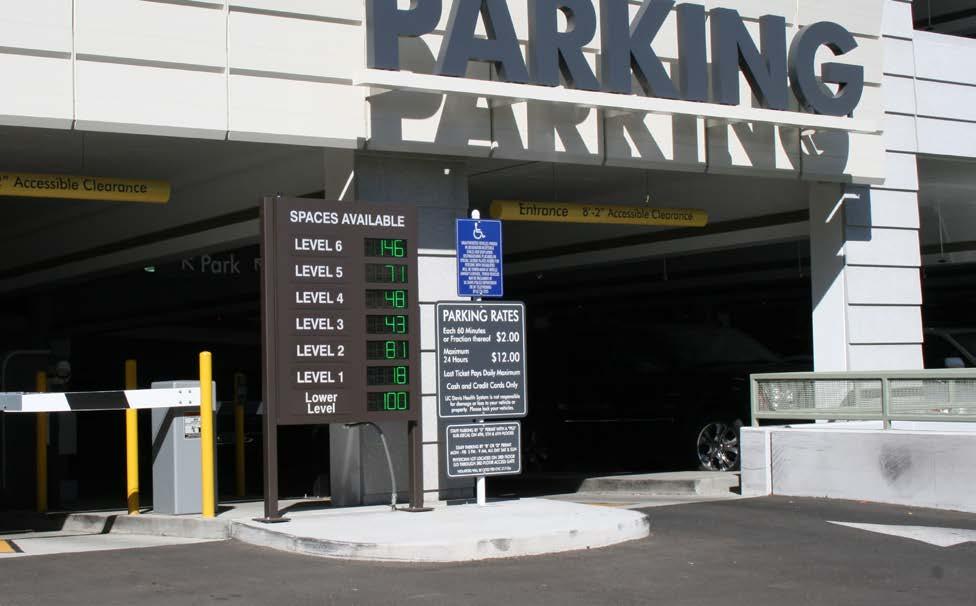

IMPLEMENTATION:
PRIORITY: CAPITAL/ START UP COST: ONGOING COST:
IMPLEMENTATION LEAD: Parking Supply + Management
• Remote work has been normalized during COVID-19 and offers potential to reduce parking demand on campus and prioritize parking supply for Patients/Visitors (PVs).
• As St. Joseph continues to respond to COVID-19 and a “new normal” emerges, conduct a detailed assessment of remote work during the pandemic and its long-term potential to reduce the number of caregivers coming to campus each day.
• Identify job classifications and number of staff who have participated in remote work during COVID-19. Identify which staff should continue to work at home and/or a remote site. These positions should be nonpatient-facing.
• Develop and adopt formal PeaceHealth policies for long-term remote work and management procedures for managers who have employees working remotely.
PRIORITY: CAPITAL/ START UP COST: ONGOING COST:
ACTION STEPS:
• Identify potential off-site work locations to reduce the number of staff on the main campus.
• Evaluate job classifications to identify which could work at off-site locations.
• Evaluate costs and benefits of off-site locations vs. work-from-home for relevant job classifications.
IMPLEMENTATION:
PRIORITY: CAPITAL/ START UP COST: ONGOING COST:
IMPLEMENTATION LEAD:
Implement a commuter benefits program and offer incentives that reduce parking demand.
• Clarify campus-specific versus PeaceHealth system-wide options for pre-tax benefits and incentives. Explore implementation of a pre-tax commuting benefits program, such as WageWorks.
• Maximize caregiver participation in the existing Smart Trips/SCOOT program. Key actions include:
• Enhance marketing, promotion, and training of program.
• Expand and diversify rewards for caregivers.
• Prioritize web-based administration of benefits and prizes, especially bus passes through Whatcom Transportation Authority (WTA) TouchPass
• Dedicate a .5 FTE to administer the program.
• Promote WTA Emergency Ride Home program.

• Increase incentives for participation in the existing caregiver carpool program. Key actions could include:
• Increasing carpool parking spaces in Lot E.
• Modify the parking policy to classify the definition of a carpool as “driver plus one” instead of three (Strategy P.5).
• Market and promote WTA vanpool program.
• Prioritize online matching of caregivers. Numerous public platforms and private vendors offer a variety of services and options for medical campuses.
• Encourage participation via other discounts or financial incentives.
• Explore implementation of a PeaceHealth-specific commute platform (e.g. RideAmigos or Luum) to manage parking permits, bus passes, carpool matching, and other travel incentives. Prioritize HR and Payroll integration (LONG-TERM).
CAPITAL/ START UP
COST:
ONGOING COST:
LEAD:
• Update existing, and invest in new, caregiver onboarding process for parking and transportation.
• Create new materials that clearly communicate parking policies, processes, and locations. Create a simple and user-friendly FAQ. Ensure that new information and materials are readily available on internal websites.
• Provide periodic updates and continuing education through Crossroads Online and The Caregiver
• Provide periodic training and resources to managers/supervisors on parking policies/processes and Smart Trips program.
• Conduct a periodic travel survey of caregivers.
IMPLEMENTATION:
PRIORITY: CAPITAL/ START UP COST: ONGOING COST:
IMPLEMENTATION
LEAD:
• Update and enhance parking and transportation maps and information on website.
• Provide additional information and collateral within hospital clarifying parking locations and rules.
• Send pre-visit communication related to parking, transportation options, and wayfinding upon arriving on campus.
IMPLEMENTATION:
PRIORITY: CAPITAL/ START UP COST: ONGOING
COST:
IMPLEMENTATION
LEAD:
Circulation + Access
• Improve lighting in parking lots, garages, and on primary pedestrian routes.
• Continue to install security cameras in parking facilities and other key locations.
• Install emergency call boxes in parking facilities and other key locations.
• Prioritize additional cleaning and maintenance in the garages.
• Prioritize additional security patrols in garages and parking lots, especially in North Parking Garage.
• Evaluate a safety escort shuttle to remote lots/garages during off-peak hours, particularly during the winter months.
IMPLEMENTATION:
PRIORITY:
CAPITAL/ START UP COST: ONGOING COST:
IMPLEMENTATION
LEAD:
Circulation + Access
• Improve pedestrian safety and connections on campus, particularly to, from, and within new parking garage, the North Parking Garage, Lot E, Lot F, gravel lots, and the HEC.
• Enhance pedestrian connections from helipad, ensuring a direct, clear, and well-marked walkway is created and that vehicle conflicts are minimized.
• Collaborate with the City of Bellingham to improve safety on Squalicum Parkway, including implementation of high-visibility marking at crosswalks and high-volume crossing locations, expanded sidewalks, enhanced lighting, and traffic calming measures.
• Update, streamline, and consolidate parking signage in lots and garages (Strategy P.9).
• Enhance pedestrian and vehicular wayfinding to/from parking facilities.
IMPLEMENTATION:
PRIORITY: CAPITAL/ START UP COST: ONGOING COST:
IMPLEMENTATION LEAD:
Enhance lighting and pedestrian enhancements connecting to North Parking Garage and outer lots
Primary pedestrian circulation routes: prioritize sidewalks, lighting along these key connections

Primary gateways and entrances: prioritize wayfinding
Circulation + Access
Provide high-quality and convenient campus amenities.
• While most caregivers and PVs drive, and will continue to do so, St. Joseph should support access by biking and walking to the greatest degree possible to reduce parking demand.
• Invest in additional secure bike parking and amenities. Key strategies would include:
• A secure bike room in the main hospital or other proximate location
• Bike racks (Inverted U or Post & Ring) at primary entrances (approximately 1 per 20-30k SF)
• Enhanced signage
• Lockers and shower facilities
• Bike fix-it stations
• As part of TO.4 and TO.5, better communicate bike parking locations.

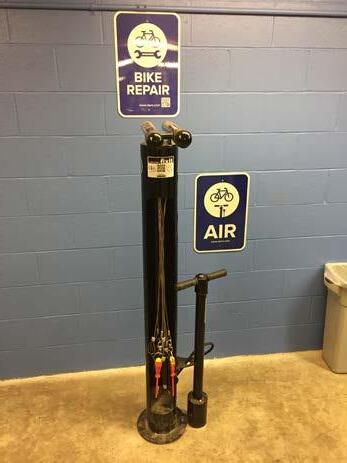
IMPLEMENTATION:
PRIORITY: CAPITAL/ START UP COST: ONGOING COST:
IMPLEMENTATION LEAD:
• Prioritize detailed evaluation of off-campus parking agreements and shuttle connections, especially in advance of, and during, new garage construction. Potential locations include:
• Clinic lots along Birchwood Avenue
• Vacant lot adjacent to St. Sophia Greek Orthodox Church
• Lots along East Sunset Drive and James Street serving Hope in Christ Church, The Church of Jesus Christ of Latter Day Saints, and former Jerns Funeral Chapel
• Sunset Square Shopping Center
• Allocate park-and-ride lots primarily for caregiver parking. Provide incentives/rewards to caregivers to encourage use of park-and-ride lots.
• Resolve key operational issues: permitting, cost-sharing, paving/ striping, safety/lighting improvements, waiting and loading areas, and access control and enforcement mechanisms.
• Create a shuttle operating plan, addressing key parameters: schedule (span and frequency), vehicle size and requirements, and operator (PeaceHealth or contracted).
PRIORITY: CAPITAL/ START UP
Circulation + Access
Collaborate with transit providers to enhance existing transit services.
• While most caregivers and Patients/Visitors (PVs) drive, and will continue to do so, St. Joseph should support access by transit to the greatest degree possible to reduce parking demand.
• Conduct a caregiver and PV transit survey to identify specific transit needs.
• In partnership with WTA, explore opportunities to enhance transit service to campus. Potential opportunities include:
• Increased service frequency and extended service span for Route 4.
• Additional bus stop amenities at Main Entrance and along Squalicum Parkway, including real-time arrival/departure information.
• Enhance communication of WTA’s Paratransit program, Travel Training, and Gold Card program to PVs and caregivers.
• As part of TO.4 and TO.5, better communicate transit services.
IMPLEMENTATION:
PRIORITY: CAPITAL/ START UP
COST: ONGOING
COST:
LEAD:
This chapter provides a high-level roadmap for implementation of the Parking and Mobility toolkit (see Chapter 4). It identifies a set of high-priority strategies and “quick win” actions that St. Joseph Medical Center can advance to catalyze improvement in the short term and set the campus up for long-term success.
Implementation is always complicated and never straightforward, as the campus will shift and evolve. Some key principles, however, can foster as efficient a process as possible, including:
Implementation of the proposed strategies will not, and should not, happen right away or all at once.
Some strategies will take additional time to plan, design, or finance, and may be dependent on implementation of others first.
Implementation of parking and mobility strategies is a “living” process, requiring ongoing monitoring and adjustment.
A “test and learn” approach is appropriate and helpful. Pilot projects, policies, or programs can help refine implementation of a campus-wide effort.
Some strategies in the toolkit may require collaboration and/or support from the larger PeaceHealth system. Consistent communication can ensure cost and administrative efficiencies.
The following strategies in the toolkit should be prioritized for short-term implementation. Specific action steps for each are outlined in Chapter 4. Plan, develop, and manage new parking supply.
P.1
Revise the existing permit system and parking regulations.
P.7 Invest in state-of-thepractice access control and enforcement tools.
P.9 Update and standardize parking information, including wayfinding and real-time parking availability.
Formalize remote work practices.
Explore off-site work locations.
Enhance campus infrastructure, staffing, and tools to improve security.
Improve campus circulation and wayfinding.
Explore use of park-andride shuttles.
In addition, the following action steps in the toolkit could be initiated in the short term to advance implementation of other important strategies.
• Explore implementation of patient valet at peak times and/or locations. (part of Strategy )
• Modify Section 6.1 of Security Policy to only require “driver plus one” to qualify for a carpool. (part of Strategy )
• Evaluate current staffing, roles, and desired skill set. Conduct a staffing audit and prepare a short- and longterm staffing plan. (part of Strategy )
• Explore implementation of a pre-tax commuting benefits program, such as WageWorks. (part of Strategy )
• Maximize caregiver participation in the existing Smart Trips/SCOOT program. (part of Strategy )
• Update existing, and invest in new, caregiver onboarding process for parking and transportation. (part of Strategy )
• Update and enhance parking and transportation maps and information on website. (part of Strategy )
• Invest in additional secure bike parking and amenities. (part of Strategy )
• Prioritize detailed evaluation of off-campus parking agreements and shuttle connections, especially in advance of, and during, new garage construction. (part of Strategy )
Prepared by:
